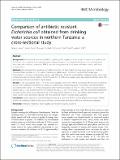| dc.description.abstract | Background: Antimicrobial resistance (AMR) is a growing and significant threat to public health on a global scale.
Escherichia coli comprises Gram-negative, fecal-borne pathogenic and commensal bacteria that are frequently
associated with antibiotic resistance. AMR E. coli can be ingested via food, water and direct contact with fecal
contamination.
Methods: We estimated the prevalence of AMR Escherichia coli from select drinking water sources in northern
Tanzania. Water samples (n = 155) were collected and plated onto Hi-Crome E. coli and MacConkey agar.
Presumptive E. coli were confirmed by using a uidA PCR assay. Antibiotic susceptibility breakpoint assays were used
to determine the resistance patterns of each isolate for 10 antibiotics. Isolates were also characterized by select PCR
genotyping and macro-restriction digest assays.
Results: E. coli was isolated from 71 % of the water samples, and of the 1819 E. coli tested, 46.9 % were resistant to
one or more antibiotics. Resistance to ampicillin, streptomycin, sulfamethoxazole, tetracycline, and trimethoprim
was significantly higher (15–30 %) compared to other tested antibiotics (0–6 %; P < 0.05). Of the β-lactam-resistant
isolates, blaTEM-1 was predominant (67 %) followed by blaCTX-M (17.7 %) and blaSHV-1 (6.0 %). Among the tetracyclineresistant
isolates, tet(A) was predominant (57.4 %) followed by tet(B) (24.0 %). E. coli isolates obtained from these
water sources were genetically diverse with few matching macro-restriction digest patterns.
Conclusion: Water supplies in northern Tanzania may be a source of AMR E. coli for people and animals. Further
studies are needed to identify the source of these contaminants and devise effective intervention strategies. | en_US |

